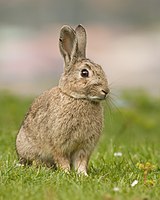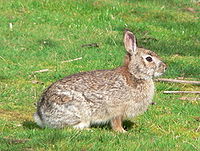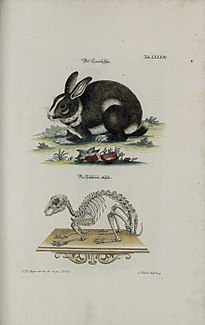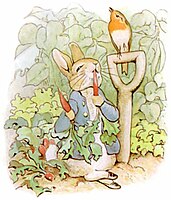Rabbit
| Rabbit | |
|---|---|
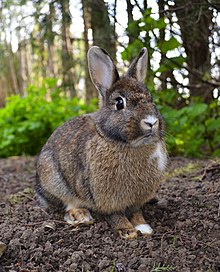
| |
| European rabbit(Oryctolagus cuniculus) | |
| Scientific classification | |
| Domain: | Eukaryota |
| Kingdom: | Animalia |
| Phylum: | Chordata |
| Class: | Mammalia |
| Order: | Lagomorpha |
| Family: | Leporidae |
| Included genera | |
| Cladisticallyincluded but traditionally excluded taxa | |
Rabbitsare smallmammalsin thefamilyLeporidae(which also includes thehares), which is in theorderLagomorpha(which also includespikas). TheEuropean rabbit,Oryctolagus cuniculusis the ancestor of the world's hundreds ofbreeds[1]ofdomestic rabbit.Sylvilagusincludes 13 wild rabbit species, among them the seven types ofcottontail.The European rabbit, which has been introduced on every continent exceptAntarctica,is familiar throughout the world as a wild prey animal, a domesticated form of livestock and a pet. With its widespread effect on ecologies and cultures, in many areas of the world, the rabbit is a part of daily life – as food, clothing, a companion, and a source of artistic inspiration.
Rabbits are aparaphyleticgrouping, and do not constitute aclade,asharesare nested within theLeporidaeclade and are not included in rabbits.
Although once consideredrodents,lagomorphs diverged earlier and have a number of traits rodents lack, including two extraincisors.
Terminology and etymology
A male rabbit is called abuck;a female is called adoe.An older term for an adult rabbit used until the 18th century isconey(derived ultimately from theLatincuniculus), whilerabbitonce referred only to the young animals.[2]Another term for a young rabbit isbunny,though this term is often applied informally (particularly by children) to rabbits generally, especially domestic ones. More recently, the termkitorkittenhas been used to refer to a young rabbit.[3][4]
A group of rabbits is known as acolonyornest(or, occasionally, awarren,though this more commonly refers to where the rabbits live).[5]A group of baby rabbits produced from a single mating is referred to as alitter[6]and a group of domestic rabbits living together is sometimes called aherd.[7]
The word rabbit itself derives from theMiddle Englishrabet,a borrowing from theWalloonrobète,which was a diminutive of the French orMiddle Dutchrobbe.[8]
Taxonomy
Rabbits and hares were formerly classified in the orderRodentia(rodent) until 1912, when they were moved into a new order,Lagomorpha(which also includespikas). Below are some of the genera and species of the rabbit.
-
Brachylagus idahoensisPygmy rabbit
-
Nesolagus netscheriSumatran striped rabbit(Model)
-
Oryctolagus cuniculusEuropean rabbit(Feral Tasmanian specimen)
-
Pentalagus furnessiAmami rabbit(Taxidermy specimen)
-
Romerolagus diaziVolcano rabbit(Taxidermy specimen)
-
Sylvilagus aquaticusSwamp rabbit(Juvenile)
-
Sylvilagus auduboniiDesert cottontail
-
Sylvilagus bachmaniBrush rabbit
-
Sylvilagus brasiliensisTapeti(Taxidermy specimen)
-
Sylvilagus floridanusEastern cottontail
- OrderLagomorpha
- FamilyLeporidae(in part)
- GenusBrachylagus
- Pygmy rabbit,Brachylagus idahoensis
- GenusBunolagus
- Bushman rabbit,Bunolagus monticularis
- GenusLepus[a]
- GenusNesolagus
- Sumatran striped rabbit,Nesolagus netscheri
- Annamite striped rabbit,Nesolagus timminsi
- GenusOryctolagus
- European rabbit,Oryctolagus cuniculus
- GenusPentalagus
- Amami rabbit/Ryūkyū rabbit,Pentalagus furnessi
- GenusPoelagus
- Central African Rabbit,Poelagus marjorita
- GenusRomerolagus
- Volcano rabbit,Romerolagus diazi
- GenusSylvilagus
- Swamp rabbit,Sylvilagus aquaticus
- Desert cottontail,Sylvilagus audubonii
- Brush rabbit,Sylvilagus bachmani
- Forest rabbit,Sylvilagus brasiliensis
- Mexican cottontail,Sylvilagus cunicularis
- Dice's cottontail,Sylvilagus dicei
- Eastern cottontail,Sylvilagus floridanus
- Tres Marias rabbit,Sylvilagus graysoni
- Omilteme cottontail,Sylvilagus insonus
- San Jose brush rabbit,Sylvilagus mansuetus
- Mountain cottontail,Sylvilagus nuttallii
- Marsh rabbit,Sylvilagus palustris
- New England cottontail,Sylvilagus transitionalis
Differences from hares
The termrabbitis typically used for all Leporidae species, excluding the genusLepus.Members of that genus are instead known asharesorjackrabbits.
Lepusspecies areprecocial,born relatively mature and mobile with hair and good vision, while rabbit species arealtricial,born hairless and blind. Hares and some rabbits live a relatively solitary life in a simple nest above the ground, while other rabbits live in social groups inburrows,which are grouped together to formwarrens.Hares are generally larger than rabbits, with ears that are more elongated and hind legs that are larger and longer. Descendants of theEuropean rabbitare commonly bred as livestock and kept as pets, whereas no hares have beendomesticated;the breed called theBelgian hareis actually adomestic rabbitwhich has been selectively bred to resemble a hare.
Domestication
Rabbits have long been domesticated. The European rabbit has been widely kept as livestock, starting inancient Rome.Selective breeding,which began in the Middle Ages, has generated awide variety of rabbit breeds,of which many (since the early 19th century) are also kept as pets.[9]Somestrainsof rabbit have been bred specifically asresearch subjects.
As livestock, rabbits are bred for their meat andfur.The earliest breeds were important sources of meat, and so became larger than wild rabbits, but domestic rabbits in modern times range in size fromdwarftogiant.Rabbit fur, prized for its softness, can be found in a broad range ofcoatcolors and patterns, as well as lengths. TheAngora rabbitbreed, for example, was developed for its long, silky fur, which is oftenhand-spuninto yarn. Other domestic rabbit breeds have been developed primarily for the commercialfur trade,including theRex,which has a shortplushcoat.
Biology

Evolution
Because the rabbit'sepiglottisis engaged over the soft palate except when swallowing, the rabbit is anobligate nasal breather.Rabbits have two sets of incisor teeth, one behind the other. This way they can be distinguished fromrodents,with which they are often confused.[10]Another difference is that for rabbits, all of their teeth continue to grow, where as for most rodents, only their incisors continue to grow.Carl Linnaeusoriginally grouped rabbits and rodents under the classGlires;later, they were separated as the scientific consensus is that many of their similarities were a result ofconvergent evolution.Recent DNA analysis and the discovery of a common ancestor has supported the view that they share a common lineage, so rabbits and rodents are now often grouped together in the superorder Glires.[11]
Morphology

Since speed and agility are a rabbit's main defenses against predators (including the swift fox), rabbits have large hind leg bones and well-developed musculature. Thoughplantigradeat rest, rabbits are on their toes while running, assuming a moredigitigradeposture. Rabbits use their strong claws for digging and (along with their teeth) for defense.[12]Each front foot has four toes plus adewclaw.Each hind foot has four toes (but no dewclaw).[13]

Most wild rabbits (especiallycompared to hares) have relatively full, egg-shaped bodies. The soft coat of the wild rabbit isagoutiin coloration (or, rarely,melanistic), which aids incamouflage.The tail of the rabbit (with the exception of thecottontail species) is dark on top and white below. Cottontails have white on the top of their tails.[14]
As a result of the position of the eyes in its skull, the rabbit has a field of vision that encompasses nearly 360 degrees, with just a small blind spot at the bridge of the nose.[15]
Hind limb elements

The anatomy of rabbits' hind limbs is structurally similar to that of other land mammals and contributes to their specialized form of locomotion. The bones of the hind limbs consist of long bones (the femur, tibia, fibula, and phalanges) as well as short bones (the tarsals). These bones are created throughendochondral ossificationduring development. Like most land mammals, the round head of the femur articulates with the acetabulum of the os coxae. The femur articulates with the tibia, but not the fibula, which is fused to the tibia. The tibia and fibula articulate with the tarsals of the pes, commonly called the foot. The hind limbs of the rabbit are longer than the front limbs. This allows them to produce their hopping form of locomotion. Longer hind limbs are more capable of producing faster speeds. Hares, which have longer legs thancottontail rabbits,are able to move considerably faster.[16]Rabbits stay just on their toes when moving; this is calleddigitigradelocomotion. The hind feet have four long toes that allow for this and are webbed to prevent them from spreading when hopping.[17]Rabbits do not have paw pads on their feet like most other animals that use digitigrade locomotion. Instead, they have coarse compressed hair that offers protection.[18]
Musculature

Rabbits have muscled hind legs that allow for maximum force, maneuverability, and acceleration that is divided into three main parts: foot, thigh, and leg. The hind limbs of a rabbit are an exaggerated feature. They are much longer than the forelimbs, providing more force. Rabbits run on their toes to gain the optimal stride during locomotion. The force put out by the hind limbs is contributed by both the structural anatomy of the fusion tibia and fibula, and muscular features.[19]
Bone formation and removal, from a cellular standpoint, is directly correlated to hind limb muscles. Action pressure from muscles creates force that is then distributed through the skeletal structures. Rabbits that generate less force, putting less stress on bones are more prone to osteoporosis due to bonerarefaction.[20]In rabbits, the more fibers in a muscle, the more resistant to fatigue. For example,hareshave a greater resistance to fatigue thancottontails.The muscles of rabbit's hind limbs can be classified into four main categories:hamstrings,quadriceps,dorsiflexors,orplantar flexors.The quadriceps muscles are in charge of force production when jumping. Complementing these muscles are the hamstrings, which aid in short bursts of action. These muscles play-off of one another in the same way as the plantar flexors and dorsiflexors, contributing to the generation and actions associated with force.[21]
Ears
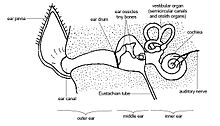

Within the order oflagomorphs,the ears are used to detect and avoid predators. In the familyLeporidae,the ears are typically longer than they are wide. For example, inblack-tailed jackrabbits,their long ears cover a greater surface area relative to their body size, which allows them to detect predators from far away. In contrast with cottontail rabbits, their ears are smaller and shorter, requiring that predators be closer before they can detect them and flee.
Evolution has favored rabbits with shorter ears, so the larger surface area does not cause them to lose heat in more temperate regions. The opposite can be seen in rabbits that live in hotter climates; possessing longer ears with a larger surface area helps with dispersion of heat. Since sound travels less well in arid as opposed to cooler air, longer ears may aid the organism in detecting predators sooner rather than later in warmer temperatures.[22][page needed]Rabbits are characterized by shorter ears than hares.[23][page needed]Rabbits' ears are an important structure to aidthermoregulationas well as in detecting predators due to the way the outer, middle, and inner ear muscles coordinate with one another. The ear muscles also aid in maintaining balance and movement when fleeing predators.[24]
Outer ear
Theauricle,also known as the pinna, is a rabbit's outer ear.[25]The rabbit's pinnae represent a fair part of the body surface area. It is theorized that the ears aid in dispersion of heat at temperatures above 30 °C (86 °F), with rabbits in warmer climates having longer pinnae due to this. Another theory is that the ears function as shock absorbers that could aid and stabilize rabbits' vision when fleeing predators, but this has typically only been seen in hares.[26][page needed]The rest of the outer ear has bent canals that lead to theeardrumortympanic membrane.[27]
Middle ear
The middle ear, separated by the outer eardrum in the back of the rabbit's skull, contains three bones: the hammer, anvil, and stirrup, collectively calledossicles,which act to decrease sound before it hits the inner ear; in general, the ossicles act as a barrier to the inner ear for sound energy.[27]
Inner ear
Inner ear fluid, calledendolymph,receives the sound energy. After receiving the energy. The inner ear comprises two parts: thecochleathat uses sound waves from the ossicles, and thevestibular apparatusthat manages the rabbit's position in regard to movement. Within the cochlea abasilar membranecontains sensory hair structures that send nerve signals to the brain, allowing it to recognize different sound frequencies. Within the vestibular apparatus three semicircular canals help detectangular motion.[27]
Dewlaps
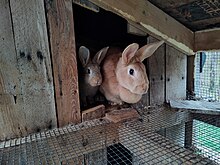
Adewlapis a longitudinal flap of skin or similar flesh that hangs beneath thelower jaworneck.It is asecondary sex characteristicin rabbits, caused by the presence of female sex hormones. They develop withpuberty.A female rabbit who has beenneuteredbefore reaching sexual maturity will not develop a dewlap, and even if a doe is neutered after developing a dewlap, the dewlap will gradually disappear over several months. This also aligns with the results of injecting male rabbits with female sex hormones, specifically the ones from pregnant women'surine.The male rabbits developed dewlaps, which then gradually disappeared once administration had ceased.[28](This is not the process of therabbit test,a common way to test for human female pregnancy in the 20th century; the pregnancy test involved dissecting female rabbits after injection with urine to see if their ovaries had enlarged.)[29]While it is unclear exactly what function a dewlap performs, pregnant female rabbits will pluck fur from their dewlaps shortly before giving birth to line a nest for their young.[30]
Thermoregulation

Thermoregulationis the process that an organism uses to maintain an optimal body temperature independent of external conditions.[31]This process is carried out by the pinnae, which takes up most of the rabbit's body surface and contain a vascular network and arteriovenous shunts.[32]In a rabbit, the optimal body temperature is around 38.5–40.0 °C (101.3–104.0 °F).[33]If their body temperature exceeds or does not meet this optimal temperature, the rabbit must return tohomeostasis.Homeostasis of body temperature is maintained by the use of their large, highly vascularized ears that are able to change the amount of blood flow that passes through the ears.
Respiratory system
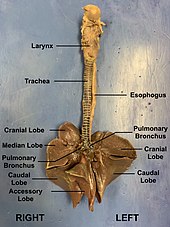
The rabbit's nasal cavity lies dorsal to the oral cavity, and the two compartments are separated by the hard and soft palate.[34]The nasal cavity itself is separated into a left and right side by a cartilage barrier, and it is covered in fine hairs that trap dust before it can enter therespiratory tract.[34][35][page needed]As the rabbit breathes, air flows in through the nostrils along the alar folds. From there, the air moves into the nasal cavity, also known as thenasopharynx,down through the trachea, through thelarynx,and into the lungs.[35][page needed][36]The larynx functions as the rabbit's voice box, which enables it to produce a wide variety of sounds.[35][page needed]The trachea is a long tube embedded with cartilaginous rings that prevent the tube from collapsing as air moves in and out of the lungs. The trachea then splits into a left and right bronchus, which meet the lungs at a structure called thehilum.From there, the bronchi split into progressively more narrow and numerous branches. The bronchi branch into bronchioles, into respiratory bronchioles, and ultimately terminate at the alveolar ducts. The branching that is typically found in rabbit lungs is a clear example of monopodial branching, in which smaller branches divide out laterally from a larger central branch.[37]
The structure of the rabbit's nasal and oral cavities necessitates breathing through the nose. This is due to the fact that the epiglottis is fixed to the backmost portion of the soft palate.[36]Within the oral cavity, a layer of tissue sits over the opening of the glottis, which blocks airflow from the oral cavity to the trachea.[34]The epiglottis functions to prevent the rabbit from aspirating on its food. Further, the presence of a soft and hard palate allow the rabbit to breathe through its nose while it feeds.[35][page needed]

Rabbits' lungs are divided into four lobes: the cranial, middle, caudal, and accessory lobes. The right lung is made up of all four lobes, while the left lung only has two: the cranial and caudal lobes.[37]To provide space for the heart, the left cranial lobe of the lungs is significantly smaller than that of the right.[34]The diaphragm is a muscular structure that lies caudal to the lungs and contracts to facilitate respiration.[34][36]
Diet and digestion
Rabbits are strictherbivoresand are suited to a diet high in fiber, mostly in the form ofcellulose.They will typicallygrazegrass upon waking up and emerging from a burrow, and will move on to consume vegetation and other plants throughout the waking period; rabbits have been known to eat a wide variety of plants, including tree leaves and fruits, though consumption of fruit and lower fiber foods is more common with pet rabbits.[38]
Easily digestible food is processed in thegastrointestinal tractand expelled as regular feces. To get nutrients out of hard to digest fiber, rabbits ferment fiber in the cecum (in the gastrointestinal tract) and then expel the contents ascecotropes,which are reingested (cecotrophy). The cecotropes are then absorbed in the small intestine to use the nutrients.[11][39]Soft cecotropes are usually consumed during periods of rest in underground burrows.[38]

Because rabbits cannot vomit,[40]if buildup occurs within the intestines (due often to a diet with insufficient fibre),[41]intestinal blockage can occur.[42]
Reproduction
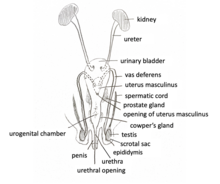
The adult male reproductive system forms the same as most mammals with the seminiferous tubular compartment containing theSertoli cellsand an adluminal compartment that contains theLeydig cells.[43]The Leydig cells producetestosterone,which maintains libido[43]and creates secondary sex characteristics such as thegenital tubercleandpenis.The Sertoli cells triggers the production ofAnti-Müllerian duct hormone,which absorbs the Müllerian duct. In an adult male rabbit, thesheath of the penisis cylinder-like and can be extruded as early as two months of age.[44]The scrotal sacs lay lateral to the penis and containepididymalfat pads which protect the testes. Between 10 and 14 weeks, the testes descend and are able to retract into the pelvic cavity to thermoregulate.[44]Furthermore, the secondary sex characteristics, such as the testes, are complex and secrete many compounds. These compounds includefructose,citric acid,minerals, and a uniquely high amount ofcatalase.[43]

The adult female reproductive tract isbipartite,which prevents an embryo from translocating between uteri.[45]The femaleurethraand vagina open into aurogenital sinuswith a singleurogenital opening.[46]The two uterine horns communicate to two cervixes and forms onevaginal canal.Along with being bipartite, the female rabbit does not go through anestrus cycle,which causes matinginduced ovulation.[44]
The average female rabbit becomes sexually mature at three to eight months of age and can conceive at any time of the year for the duration of her life. Egg and sperm production can begin to decline after three years.[43]During mating, the male rabbit will insert his penis into the female from behind, make rapid pelvic thrusts untilejaculation,and throw himself backward off the female.Copulationlasts only 20–40 seconds.[47]
The rabbitgestationperiod is short and ranges from 28 to 36 days with an average period of 31 days. A longer gestation period will generally yield a smaller litter while shorter gestation periods will give birth to a larger litter. The size of a single litter can range from four to 12 kits allowing a female to deliver up to 60 new kits a year. After birth, the female can become pregnant again as early as the next day.[44]
After mating, in some species, hormonal changes will cause the doe to begin to dig a burrow for her nest about a week before giving birth. Between three days and a few hours before giving birth another series of hormonal changes will cause her to prepare the nest structure. The doe will first gather grass for a structure, and an elevation inprolactinshortly before birth will cause her fur to shed that the doe will then use to line the nest, providing insulation for the newborn kits.[48]
The mortality rates of embryos are high in rabbits and can be due to infection, trauma, poor nutrition and environmental stress so a high fertility rate is necessary to counter this.[44]
Sleep
Rabbits may appear to becrepuscular,but their natural inclination is towardnocturnalactivity.[49]In 2011, the average sleep time of a rabbit in captivity was calculated at 8.4 hours per day.[50]As with otherprey animals,rabbits often sleep with their eyes open, so that sudden movements will awaken the rabbit to respond to potential danger.[51]
Diseases and immunity
In addition to being at risk of disease from common pathogens such asBordetella bronchisepticaandEscherichia coli,rabbits can contract the virulent, species-specific virusesRHD( "rabbit hemorrhagic disease", a form of calicivirus)[52]ormyxomatosis.Among the parasites that infect rabbits are tapeworms (such asTaenia serialis),external parasites (including fleas and mites),coccidiaspecies,Encephalitozoon cuniculi,[53]andToxoplasma gondii.[54][55]Domesticated rabbits with a diet lacking in high-fiber sources, such as hay and grass, are susceptible to potentially lethal gastrointestinal stasis.[56]Rabbits and hares are almost never found to be infected withrabiesand have not been known to transmit rabies to humans.[57]
Rabbit immunity has significantly diverged from othertetrapodsin the manner in which it employsimmunoglobulin light chains.[58][59]In one case, McCartney-Francis (et al.,1984) discovered a unique additionaldisulfide bondbetweenCys80 in Vκ and Cys 171 in Cκ.[58][59]They suggest that this may serve to stabilise rabbit antibodies.[58][59]Meanwhile,IGKC1shows highamino aciddivergence between domesticated types andferalsderived from them.[59]This can be as high as 40%.[59]
Rabbit hemorrhagic disease(RHD) is caused by strains ofrabbit hemorrhagic disease virus(RHDV), includingtype 2(RHDV2).[60]RHDV2 was detected for the first time inWashington,United States, in May 2022, and then in August, once in Washington and twice inOregon.[61]Since then, it has spread to many states in the United States.
Ecology

Rabbits arepreyanimals and are therefore constantly aware of their surroundings. For instance, in Mediterranean Europe, rabbits are the main prey of red foxes, badgers, and Iberian lynxes.[62]If confronted by a potential threat, a rabbit may freeze and observe then warn others in the warren with powerful thumps on the ground. Rabbits have a remarkably wide field of vision, and a good deal of it is devoted to overhead scanning.[63]A rabbit eye has no fovea, but a "visual streak", a horizontal line in the middle of the retina that both rod and cone cell densities are the highest. This allows them to scan the horizon with little head turning.[64][65]The doe (mother) is aware that she gives off scent which can attract predators, so she will stay away from the nest to avoid putting the kits (babies) in danger, returning the nest only a few times a day to feed the kits.[66]
Rabbits survive predation by burrowing (in some species), hopping away in a zig-zag motion, and, if captured, delivering powerful kicks with their hind legs. Their strong teeth allow them to bite to escape a struggle.[67]The longest-lived rabbit on record, a domesticatedEuropean rabbitliving inTasmania,died at age 18.[68]The lifespan of wild rabbits is much shorter; the average longevity of aneastern cottontail,for instance, is less than one year.[69]
Habitat and range

Rabbit habitats includemeadows,woods,forests,grasslands,desertsandwetlands.[70]While some rabbits live solitary lives, others live in groups, and theEuropean rabbit,lives inburrows,or rabbit holes. A group of burrows is called awarren.[70]
More than half of the world's rabbit population resides in North America.[70]They are also native to southwestern Europe, Southeast Asia,Sumatra,some islands of Japan, and parts of Africa and South America. They are not naturally found in most ofEurasia,where a number of species ofharesare present. Rabbits first entered South America relatively recently, as part of theGreat American Interchange.Much of the continent has just one species of rabbit, thetapeti,while most of South America'sSouthern Conehas no rabbits. The European rabbit has been introduced to many places around the world.[14]A recent study found that "the (so-called) Chinese rabbits were introduced from Europe. Genetic diversity in Chinese rabbits was very low."[71]
Rabbits have beenlaunched into space orbit.[72]
Environmental problems

Rabbits have been a source of environmental problems when introduced into the wild by humans. As a result of their appetites, and the rate at which they breed,feralrabbit depredation can be problematic for agriculture. Gassing (fumigationof warrens),[73]barriers (fences),shooting, snaring, andferretinghave been used to control rabbit populations, but the most effective measures are diseases such asmyxomatosis(myxoormixi,colloquially) andcalicivirus.In Europe, where rabbits are farmed on a large scale, they are protected against myxomatosis and calicivirus with agenetically modified virus.The virus was developed in Spain. If it were to make its way into wild populations, it could create a population boom, as those diseases are the most serious threats to rabbit survival. Rabbits in Australia and New Zealand are considered to be such a pest that landowners are legally obliged to control them.[74][75]
Rabbits are known to be able to catch fire and spread wildfires, but the efficiency and relevance of this method has been doubted by forest experts who contend that a rabbit on fire could move some meters.[76][77]Knowledge on fire-spreading rabbits is based on anecdotes as there is no known scientific investigation on the subject.[77]
As food and clothing

In some areas, wild rabbits and hares are hunted for their meat, a lean source of high quality protein.[78]In the wild, such hunting is accomplished with the aid of trainedfalcons,ferrets,ordogs,as well as withsnaresor other traps and rifles. A caught rabbit may be dispatched with a sharp blow to the back of its head, a practice from which the termrabbit punchis derived.
Wild leporids comprise a small portion of global rabbit-meat consumption. Domesticated descendants of the European rabbit (Oryctolagus cuniculus) that are bred and kept as livestock (a practice calledcuniculture) account for the estimated 200million tons of rabbit meat produced annually.[79]Approximately 1.2 billion rabbits are slaughtered each year for meat worldwide.[80]In 1994, the countries with the highest consumption per capita of rabbit meat wereMaltawith 8.89 kg (19.6 lb), Italy with 5.71 kg (12.6 lb), andCypruswith 4.37 kg (9.6 lb), falling to 0.03 kg (0.07 lb) in Japan. The figure for the United States was 0.14 kg (0.31 lb) per capita. The largest producers of rabbit meat in 1994 were China, Russia, Italy, France, and Spain.[81]Rabbit meat was once a common commodity in Sydney, but declined after themyxomatosisvirus was intentionally introduced to control the exploding population offeral rabbits in the area.
In the United Kingdom, fresh rabbits are sold in butcher shops and markets, and some supermarkets sell frozen rabbit meat. At farmers markets there, including the famousBorough Marketin London, rabbit carcasses are sometimes displayed hanging, unbutchered (in the traditional style), next to braces ofpheasantor other small game. Rabbit meat is a feature of Moroccan cuisine, where it is cooked in atajinewith "raisins and grilled almonds added a few minutes before serving".[82]In China, rabbit meat is particularly popular inSichuan cuisine,with its stewed rabbit, spicy diced rabbit, BBQ-style rabbit, and even spicy rabbit heads, which have been compared tospicy duck neck.[79]Rabbit meat is comparatively unpopular elsewhere in theAsia–Pacific.
An extremely rare infection associated with rabbits-as-food istularemia(also known asrabbit fever), which may be contracted from an infected rabbit.[83]Inhaling the bacteria during the skinning process increases the risk of getting tularemia.
In addition to their meat, rabbits are used for theirwool,fur,andpelts,as well as their nitrogen-rich manure and their high-protein milk.[84]Production industries have developed domesticated rabbit breeds (such as theAngora rabbit) for the purpose of meeting these needs.
Behaviors
Binkies,also more generally calledzoomies,[85]in rabbits are characterized by a sudden kick with their hind legs, shaking their heads sideways (usually mid-air), and running around rapidly. Another term ishalf-binky,which is characterized by a shorter span and a sharp flick of the head. Both types of binkies indicate happiness or excitement.[better source needed]All of which typically only last for around a second. A rabbit might do quick, rapid multiple binkies in one session. It is thought to be a practice run in case they need to escape from danger.[86]Binkies more commonly occur in domesticated rabbits living in a comfortable environment.[87]
Rabbits mostly use full-body actions, likeflopping,to communicate emotion to other rabbits and humans. Rabbits flopping in front of other rabbits can be meant as a non-aggressive insult.[88][89]Rabbits commonly smell the ground first, then tilt their head to the side with a subtle jerky movement to lie down to its side, which exposes their belly. They may thump their hind feet on the ground to signal other rabbits that they're feeling threatened or that potential dangers are near their territory. Some domesticated rabbits might thump to get their owner's attention. Not all rabbits thump.[90]
Both sexes of rabbits often rub their chins on objects or people with theirscent glandlocated under the chin. This is the rabbit's way of marking their territory or possessions for other rabbits to recognize by depositing scent gland secretions. It might also serve as a reminder for the rabbit to return and investigate the object later, helping them navigate in the dark and to help them in their recollection of where they have been.[speculation?]Rabbits who have bonded will respect each other's smell, which indicates a territorial border.[91][92]
In culture
This sectionneeds additional citations forverification.(October 2022) |
Rabbits are often posited by scholars as symbols offertilityand spring. TheEaster Bunnyis a figure from Lutheran German folklore that then spread to America and later other parts of the world and is similar toSanta Claus.The rabbits' role as a prey animal with few defenses evokes vulnerability and innocence and in folklore and modern children's stories, rabbits often appear as sympathetic characters, able to connect easily with youth of all kinds (for example, theVelveteen RabbitorThumperinBambi).[citation needed]
With its reputation as a prolific breeder, the rabbit juxtaposessexualitywith innocence, as in thePlayboy Bunny.The rabbit is also known for its speed, agility, and endurance, symbolized (for example) by the marketing icons theEnergizer Bunnyand theDuracell Bunny.[citation needed]
Folklore
The rabbit often appears in folklore as thetricksterarchetypeas he uses his cunning to outwit his enemies.
- InAztec mythology,a pantheon of four hundred rabbit gods known asCentzon Totochtin,led byOmetochtlior Two Rabbit, represented fertility, parties, and drunkenness.
- In Central Africa, the common hare (Kalulu), is "inevitably described" as a trickster figure.[93]
- InChinese folklore,rabbits accompanyChang'eon the Moon. In theChinese New Year,thezodiacal rabbitis one of the twelve celestial animals in theChinese zodiac.TheVietnamese zodiacincludes azodiacal catin place of the rabbit. The most common explanation is that the ancient Vietnamese word for "rabbit"(mao)sounds like the Chinese word for "cat" (Mão,mao).[94]
- InJapanese tradition,rabbitslive on the Moonwhere they makemochi,the popular snack of mashedsticky rice.This comes from interpreting the pattern of dark patches on the moon as a rabbit standing on tiptoes on the left pounding on anusu,a Japanese mortar.
- InJewish folklore,rabbits (shfanim, שפנים) are associated with cowardice, a usage still current in contemporary Israeli spokenHebrew(similar to the English colloquial use of "chicken" to denote cowardice).
- InKorean mythology,as in Japanese, rabbits live on the moon making rice cakes ( "Tteok"in Korean).
- InAnishinaabe traditional beliefs,held by theOjibweand some otherNative Americanpeoples,Nanabozho,or Great Rabbit, is an important deity related to the creation of the world.
- A Vietnamese myth portrays the rabbit as innocent and youthful. The gods of the myth are shown to be hunting and killing rabbits to show off their power.
- Buddhism,Christianity, and Judaism have associations with an ancient circular motif called thethree rabbits(or "three hares" ). Its meaning ranges from "peace and tranquility", to purity or theHoly Trinity,toKabbalistic levels of the soulor to theJewish diaspora.The tripartite symbol also appears inheraldryand eventattoos.
The rabbit astricksteris a part of American popular culture, asBr'er Rabbit(from African-American folktales and, later,Disney animation) andBugs Bunny(thecartooncharacter fromWarner Bros.), for example.
Anthropomorphized rabbits have appeared in film and literature, inAlice's Adventures in Wonderland(theWhite Rabbitand theMarch Harecharacters), inWatership Down(including thefilmandtelevisionadaptations), inRabbit Hill(byRobert Lawson), and in thePeter Rabbitstories (byBeatrix Potter). In the 1920s,Oswald the Lucky Rabbitwas a popular cartoon character.
Arabbit's footmay be carried as anamulet,believed to bring protection andgood luck.This belief is found in many parts of the world, with the earliest use being recorded in Europe c. 600 BC.[95]
On theIsle of Portlandin Dorset, UK, the rabbit is said to be unlucky, and speaking the creature's name can cause upset among older island residents. This is thought to date back to early times in the local quarrying industry, where, to save space, extracted stones that were not fit for sale were set aside in what became tall, unstable walls. The local rabbits' tendency to burrow there would weaken the walls, and their collapse would result in injuries or even death. In the local culture to this day, the rabbit (when he has to be referred to) may instead be called a "long ears" or "underground mutton" so as not to risk bringing a downfall upon oneself.[96]
In other parts of Britain and in North America, "Rabbit rabbit rabbit"is one variant of anapotropaicortalismanicsuperstition that involves saying or repeating the word "rabbit" (or "rabbits" or "white rabbits" or some combination thereof) out loud upon waking on the first day of each month, because doing so is believed to ensure good fortune for the duration of that month.[97]
The "rabbit test" is a term first used in 1949 for theFriedman test,an early diagnostic tool for detecting a pregnancy in humans. It is a common misconception (or perhaps anurban legend) that the test-rabbit would die if the woman was pregnant. This led to the phrase "the rabbit died" becoming a euphemism for a positive pregnancy test.[98]
Many modern children's stories and cartoons portray rabbits as particularly fond of eating carrots. This is a misleading as wild rabbits do not naturally prefer carrots over other plants. Carrots are high in sugar, and excessive consumption can be unhealthy.[99]This has led to some owners of domestic rabbits feeding a carrot heavy diet on this false perception.[100][101]
-
Rabbit fools Elephant by showing the reflection of the moon.Illustration (from 1354) of thePanchatantra
-
WWIIUSAFpilot D. R. Emerson "with a rabbit's foot talisman, a gift from a New York girl friend"
-
Saint Jerome in the Desert,byTaddeo Crivelli(died about 1479)
See also
References
Notes
- ^This genus is a hare, not a rabbit.
Citations
- ^"Data export".DAD-IS (Domestic Animal Diversity Information System).FAO (Food and Agriculture Organization of the United Nations). 21 November 2017.Retrieved30 March2018.
- ^"coney".Online Etymology Dictionary.Retrieved2 March2018.
- ^Booth, J.L.; Peng, X.; Baccon, J.; Cooper, T.K. (2013)."Multiple complex congenital malformations in a rabbit kit (Oryctolagus cuniculi)".Comparative Medicine.63(4): 342–347.PMC3750670.PMID24209970.
- ^Zapletal, D.; Švancarová, D.; Gálik, B. (2021)."Growth of suckled rabbit kits depending on litter size at birth".Acta Fytotechnica et Zootechnica.24(1): 55–59.doi:10.15414/afz.2021.24.01.55-59.ISSN1335-258X.
- ^"The Collective Noun Page".Archivedfrom the original on 1 February 2008.Retrieved30 January2008.
- ^McClure, Diane (2018)."Breeding and Reproduction of Rabbits".Merck Veterinary Manual.Archivedfrom the original on 6 January 2018.Retrieved5 January2018.
- ^"Common Questions: What Do You Call a Group of...?".archived copy of Animal Congregations, or What Do You Call a Group of.....?.U.S. Geological Survey Northern Prairie Wildlife Research Center. Archived fromthe originalon 20 March 2015.Retrieved26 February2018.
- ^"rabbit".Online Etymology Dictionary.Retrieved15 July2021.
- ^Irving-Pease, Evan K.; Frantz, Laurent A.F.; Sykes, Naomi; Callou, Cécile; Larson, Greger (2018)."Rabbits and the Specious Origins of Domestication".Trends in Ecology & Evolution.33(3): 149–152.Bibcode:2018TEcoE..33..149I.doi:10.1016/j.tree.2017.12.009.ISSN0169-5347.PMID29454669.S2CID3380288.
- ^Brown, Louise (2001).How to Care for Your Rabbit.Kingdom Books. p. 6.ISBN978-1-85279-167-4.
- ^abKatherine Quesenberry & James W. Carpenter,Ferrets, Rabbits, and Rodents: Clinical Medicine and Surgery(3rd ed. 2012).
- ^d'Ovidio, Dario; Pierantoni, Ludovica; Noviello, Emilio; Pirrone, Federica (September 2016). "Sex differences in human-directed social behavior in pet rabbits".Journal of Veterinary Behavior.15:37–42.doi:10.1016/j.jveb.2016.08.072.
- ^van Praag, Esther (2005)."Deformed claws in a rabbit, after traumatic fractures"(PDF).MediRabbit.
- ^ab"rabbit".Encyclopædia Britannica(Standard ed.). Chicago:Encyclopædia Britannica, Inc.2007.
- ^"What do Rabbits See?".Archivedfrom the original on 23 September 2015.Retrieved9 August2013.
- ^Bensley, Benjamin Arthur (1910).Practical anatomy of the rabbit.The University Press. p.1.
rabbit skeletal anatomy.
- ^"Description and Physical Characteristics of Rabbits – All Other Pets – Merck Veterinary Manual".Merck Veterinary Manual.Retrieved11 May2018.
- ^D.A.B.V.P., Margaret A. Wissman, D.V.M."Rabbit Anatomy".exoticpetvet.net.Retrieved11 May2018.
{{cite web}}:CS1 maint: multiple names: authors list (link) - ^Susan, Lumpkin; Seidensticker, John (2011).Rabbits: the animal answer guide.Baltimore: Johns Hopkins University Press.ISBN978-1-4214-0126-3.OCLC794700391.
- ^Geiser, Max; Trueta, Joseph (May 1958)."Muscle action, bone rarefaction and bone formation".The Journal of Bone and Joint Surgery. British Volume.40-B(2): 282–311.doi:10.1302/0301-620X.40B2.282.PMID13539115.
- ^Lieber, Richard L.; Blevins, Field T. (January 1989). "Skeletal muscle architecture of the rabbit hindlimb: Functional implications of muscle design".Journal of Morphology.199(1): 93–101.doi:10.1002/jmor.1051990108.PMID2921772.S2CID25344889.
- ^Hall, E. Raymond (2001).The Mammals of North America.The Blackburn Press.ISBN978-1-930665-35-4.
- ^Bensley, Benjamin Arthur (1910).Practical anatomy of the rabbit.The University Press.
- ^Meyer, D. L. (1971). "Single Unit Responses of Rabbit Ear-Muscles to Postural and Accelerative Stimulation".Experimental Brain Research.14(2): 118–26.doi:10.1007/BF00234795.PMID5016586.S2CID6466476.
- ^Capello, Vittorio (2006)."Lateral Ear Canal Resection and Ablation in Pet Rabbits"(PDF).The North American Veterinary Conference.20:1711–1713.
- ^Vella, David (2012).Ferrets, Rabbits, and Rodents: Clinical Medicine and Surgery.Elsevier.ISBN978-1-4160-6621-7.
- ^abcParsons, Paige K. (2018)."Rabbit Ears: A Structural Look:...injury or disease, can send your rabbit into a spin".House Rabbit Society.
- ^Hu, C.-k.; Frazier, C. N. (1 February 1938)."Relationship Between Female Sex Hormone and Dewlap in the Rabbit".Experimental Biology and Medicine.38(1): 116–119.doi:10.3181/00379727-38-9761.ISSN1535-3702.S2CID87987542.
- ^Howe, Marvine (10 March 1991). "Dr Maurice Friedman 87 Dies Created Rabbit Pregnancy Test".The New York Times.
- ^Vennen, Kristine M.; Mitchell, Mark A. (1 January 2009), Mitchell, Mark A.; Tully, Thomas N. (eds.), "Rabbits",Manual of Exotic Pet Practice,Saint Louis: W.B. Saunders: 375–405,doi:10.1016/b978-141600119-5.50017-2,ISBN978-1-4160-0119-5,PMC7152457
- ^Romanovsky, A. A. (March 2014)."Skin temperature: its role in thermoregulation".Acta Physiologica.210(3): 498–507.doi:10.1111/apha.12231.PMC4159593.PMID24716231.
- ^Vella, David (2012).Ferrets, Rabbits, and Rodents: Clinical, Medicine, and Surgery.Elsevier.ISBN978-1-4160-6621-7.[page needed]
- ^Fayez, I; Marai, M; Alnaimy, A; Habeeb, M (1994)."Thermoregulation in rabbits".In Baselga, M; Marai, I.F.M. (eds.).Rabbit production in hot climates.Zaragoza: CIHEAM. pp. 33–41.
- ^abcdeJohnson-Delaney, Cathy A.; Orosz, Susan E. (2011). "Rabbit Respiratory System: Clinical Anatomy, Physiology and Disease".Veterinary Clinics of North America: Exotic Animal Practice.14(2): 257–266.doi:10.1016/j.cvex.2011.03.002.PMID21601814.
- ^abcdSmith, David G.; Schenk, Michael P. (2019).A dissection guide & atlas to the rabbit.Morton.ISBN978-1-61731-937-2.OCLC1084742187.
- ^abcJekl, Vladimi (2012)."Approach to Rabbit Respiratory Disease".WSAVA/FECAVA/BSAVA World Congress.
As obligate nasal breathers, rabbits with upper airway disease will attempt to breathe through their mouths, which prevents feeding and drinking and could be quickly fatal.
- ^abAutifi, Mohamed Abdul Haye; El-Banna, Ahmed Kamal; Ebaid, Ashraf El- Sayed (2015)."Morphological Study of Rabbit Lung, Bronchial Tree, and Pulmonary Vessels Using Corrosion Cast Technique".Al-Azhar Assiut Medical Journal.13(3): 41–51.
- ^abVarga, M. (2013)."Rabbit Basic Science".Textbook of Rabbit Medicine:3–108.doi:10.1016/B978-0-7020-4979-8.00001-7.ISBN978-0-7020-4979-8.PMC7158370.
- ^"Exploring a Rabbit's Unique Digestive System".Rabbits for Dummies.Retrieved14 August2013.
- ^Bernard E. Rollin (13 March 1995).The Experimental Animal in Biomedical Research: Care, Husbandry, and Well-Being-An Overview by Species, Volume 2.CRC Press. p. 359.ISBN978-0-8493-4982-9.
- ^Karr-Lilienthal, Phd (University of Nebraska – Lincoln), Lisa (4 November 2011)."The Digestive System of the Rabbit".eXtension (a Part of the Cooperative Extension Service).Archivedfrom the original on 6 January 2018.Retrieved5 January2018.
- ^"Living with a House Rabbit".Archivedfrom the original on 21 September 2017.Retrieved21 September2017.
- ^abcdFoote, Robert H; Carney, Edward W (2000). "The rabbit as a model for reproductive and developmental toxicity studies".Reproductive Toxicology.14(6): 477–493.Bibcode:2000RepTx..14..477F.doi:10.1016/s0890-6238(00)00101-5.ISSN0890-6238.PMID11099874.
- ^abcde"Rabbit Reproduction Basics".LafeberVet.5 May 2014.Retrieved6 May2019.
- ^Weisbroth, Steven H.; Flatt, Ronald E.; Kraus, Alan L. (1974).The Biology of the Laboratory Rabbit.doi:10.1016/c2013-0-11681-9.ISBN978-0-12-742150-6.
- ^Lukefahr, Steven D.; McNitt, James I.; Cheeke, Peter R.; Patton, Nephi M. (29 April 2022).Rabbit Production, 10th Edition.CABI.ISBN978-1-78924-978-1.
- ^"Understanding the Mating Process for Breeding Rabbits".florida4h.org.Retrieved12 April2019.
- ^Benedek, I; Altbӓcker, V; Molnár, T (2021)."Stress reactivity near birth affects nest building timing and offspring number and survival in the European rabbit (Oryctolagus cuniculus) ".PLOS ONE.16(1): e0246258.Bibcode:2021PLoSO..1646258B.doi:10.1371/journal.pone.0246258.PMC7845978.PMID33513198.
- ^Jilge, B (1991). "The rabbit: a diurnal or a nocturnal animal?".Journal of Experimental Animal Science.34(5–6): 170–183.PMID1814463.
- ^"40 Winks?" Jennifer S. Holland,National GeographicVol. 220, No. 1. July 2011.
- ^Wright, Samantha (2011).For The Love of Parsley. A Guide To Your Rabbit's Most Common Behaviours.Lulu. pp. 35–36.ISBN978-1-4467-9111-0.
- ^Cooke, Brian Douglas (2014).Australia's War Against Rabbits.CSIRO Publishing.ISBN978-0-643-09612-7.Archivedfrom the original on 7 June 2014.
- ^Latney, La’Toya (2014)."Encephalitozoon cuniculiin pet rabbits: diagnosis and optimal management ".Veterinary Medicine: Research and Reports.5:169–180.doi:10.2147/VMRR.S49842.PMC7337189.PMID32670857.
- ^Wood, Maggie."Parasites of Rabbits".Chicago Exotics, PC.Archived fromthe originalon 2 March 2013.Retrieved8 April2013.
- ^Boschert, Ken."Internal Parasites of Rabbits".Net Vet.Archivedfrom the original on 2 April 2013.Retrieved8 April2013.
- ^Krempels, Dana."GastroIntestinal Stasis, The Silent Killer".Department of Biology at the University of Miami.Archivedfrom the original on 19 June 2017.Retrieved21 September2017.
- ^"Rabies: Other Wild Animals".Centers for Disease Control and Prevention. 15 November 2011.Archivedfrom the original on 20 December 2010.Retrieved20 December2012.
- ^abc
- •Weber, Justus; Peng, Haiyong; Rader, Christoph (2017)."From rabbit antibody repertoires to rabbit monoclonal antibodies".Experimental & Molecular Medicine.49(3).Nature Portfolio:e305.doi:10.1038/emm.2017.23.ISSN2092-6413.PMC5382564.PMID28336958.S2CID4066391.
- •Mage, Rose G.; Lanning, Dennis; Knight, Katherine L. (2006). "B cell and antibody repertoire development in rabbits: The requirement of gut-associated lymphoid tissues".Developmental & Comparative Immunology.30(1–2).Elsevier:137–153.doi:10.1016/j.dci.2005.06.017.ISSN0145-305X.PMID16098588.
- •Conrath, K.E.; Wernery, U.; Muyldermans, S.; Nguyen, V.K. (2003). "Emergence and evolution of functional heavy-chain antibodies inCamelidae".Developmental & Comparative Immunology.27(2).Elsevier:87–103.doi:10.1016/s0145-305x(02)00071-x.ISSN0145-305X.PMID12543123.
- •Davis, Mark M. (1985). "Molecular Genetics of the T Cell-Receptor Beta Chain".Annual Review of Immunology.3(1).Annual Reviews:537–560.doi:10.1146/annurev.iy.03.040185.002541.ISSN0732-0582.PMID3933533.
- ^abcdePinheiro, Ana; Neves, Fabiana; Lemos de Matos, Ana; Abrantes, Joana; van der Loo, Wessel; Mage, Rose; Esteves, Pedro José (23 September 2015)."An overview of the lagomorph immune system and its genetic diversity".Immunogenetics.68(2).Springer:83–107.doi:10.1007/s00251-015-0868-8.ISSN0093-7711.PMID26399242.S2CID18131774.
- ^"Rabbit hemorrhagic disease".American Veterinary Medical Association.Retrieved7 August2022.
- ^"Deadly rabbit disease confirmed in Thurston County; vets urge vaccination".Washington State Department of Agriculture.25 September 2020.Retrieved7 August2022.
- ^Fedriani, J. M.; Palomares, F.; Delibes, M. (1999)."Niche relations among three sympatric Mediterranean carnivores"(PDF).Oecologia.121(1): 138–148.Bibcode:1999Oecol.121..138F.CiteSeerX10.1.1.587.7215.doi:10.1007/s004420050915.JSTOR4222449.PMID28307883.S2CID39202154.Archived(PDF)from the original on 4 March 2016.
- ^Tynes, Valarie V.Behavior of Exotic PetsArchived6 May 2016 at theWayback Machine.Wiley Blackwell, 2010, p. 70.
- ^Bringmann, Andreas; Syrbe, Steffen; Görner, Katja; Kacza, Johannes; Francke, Mike; Wiedemann, Peter; Reichenbach, Andreas (1 September 2018)."The primate fovea: Structure, function and development".Progress in Retinal and Eye Research.66:49–84.doi:10.1016/j.preteyeres.2018.03.006.ISSN1350-9462.PMID29609042.
- ^Lavaud, Arnold; Soukup, Petr; Martin, Louise; Hartnack, Sonja; Pot, Simon (23 April 2020)."Spectral Domain Optical Coherence Tomography in Awake Rabbits Allows Identification of the Visual Streak, a Comparison with Histology".Translational Vision Science & Technology.9(5): 13.doi:10.1167/tvst.9.5.13.ISSN2164-2591.PMC7401941.PMID32821485.
- ^"How To Keep A Wild Baby Rabbit Alive — Rabbit Care Tips".Rabbitcaretips.com. 24 February 2021.Retrieved30 June2022.
- ^Davis, Susan E. and DeMello, MargoStories Rabbits Tell: A Natural And Cultural History of A Misunderstood CreatureArchived6 May 2016 at theWayback Machine.Lantern Books, 2003, p. 27.
- ^Glenday, Craig (2013).Guinness World Records 2014.Guinness World Records Limited. pp.043.ISBN978-1-908843-15-9.
- ^Cottontail rabbit at Indiana Department of Natural ResourcesArchived17 November 2016 at theWayback Machine
- ^abc"Rabbit Habitats".Archived fromthe originalon 4 August 2009.Retrieved7 July2009.
- ^Long, J.-R.; Qiu, X.-P.; Zeng, F.-T.; Tang, L.-M.; Zhang, Y.-P. (April 2003). "Origin of rabbit (Oryctolagus cuniculus) in China: evidence from mitochondrial DNA control region sequence analysis ".Animal Genetics.34(2): 82–87.doi:10.1046/j.1365-2052.2003.00945.x.PMID12648090.
- ^Beischer, DE; Fregly, AR (1962)."Animals and man in space. A chronology and annotated bibliography through the year 1960".US Naval School of Aviation Medicine.ONR TR ACR-64 (AD0272581). Archived from the original on 11 August 2015.Retrieved14 June2011.
{{cite journal}}:CS1 maint: unfit URL (link) - ^Department of Primary Industries and Regional Development; Agriculture and Food Division; Pest and Disease Information Service (PaDIS)."Rabbit control: fumigation".agric.wa.gov.au.Government of Western Australia.Retrieved25 September2021.
- ^"Feral animals in Australia — Invasive species".Environment.gov.au. 1 February 2010.Archivedfrom the original on 21 July 2010.Retrieved30 August2010.
- ^"Rabbits — The role of government — Te Ara Encyclopedia of New Zealand".Teara.govt.nz. 1 March 2009.Archivedfrom the original on 12 June 2011.Retrieved30 August2010.
- ^Jerez, Sara (23 February 2023).""Es cierto": Experto confirma que conejos y otros animales en llamas sí pueden propagar incendios ".Radio Bío-Bío(in Spanish).Retrieved23 February2023.
- ^abdel Mar Parra, Maria (23 February 2023)."Experto forestal:" Los conejos no son un agente significativo de propagación de incendios "".El Desconcierto(in Spanish).Retrieved23 February2023.
- ^"Rabbit: From Farm to Table".Archived fromthe originalon 5 July 2008.
- ^abOlivia Geng,French Rabbit Heads: The Newest Delicacy in Chinese CuisineArchived14 July 2017 at theWayback Machine.The Wall Street Journal Blog, 13 June 2014
- ^"FAOSTAT".FAO.Retrieved25 October2019.
- ^FAO – The Rabbit – Husbandry, health and production.Archived23 April 2015 at theWayback Machine
- ^'Traditional Moroccan Cooking, Recipes from Fez', by Madame Guinadeau. (Serif, London, 2003).ISBN1-897959-43-5.
- ^"Tularemia (Rabbit fever)".Health.utah.gov. 16 June 2003. Archived fromthe originalon 26 May 2010.Retrieved30 August2010.
- ^Houdebine, Louis-Marie; Fan, Jianglin (1 June 2009).Rabbit Biotechnology: Rabbit Genomics, Transgenesis, Cloning and Models.シュプリンガー・ジャパン chu thức hội xã. pp. 68–72.ISBN978-90-481-2226-4.Archivedfrom the original on 26 April 2014.Retrieved26 February2018.
- ^"Zoomies explained | Blog".Burgess Pet Care.Retrieved9 March2024.
- ^Claire Speight RVN (5 June 2022)."Bunny binkies: Why rabbits binky and how to encourage it".PetsRadar.Retrieved1 October2023.
- ^Harding, Bryan (24 February 2021)."Why Do Rabbits Binky?".North American Nature.Retrieved1 October2023.
- ^Carter, Lou (17 August 2020)."Why Does My Rabbit Flop Over? Bunny Flopping Meaning!".Rabbit Care Tips.Retrieved1 October2023.
- ^"Binkies, Nose Bonks and Flops | Rabbit Behavior".My House Rabbit.Retrieved1 October2023.
- ^"Why Do Rabbits Thump? – Lafeber Co. – Small Mammals".Retrieved1 October2023.
- ^Carter, Lou (31 August 2019)."Why is My Rabbit Chinning Everything?".Rabbit Care Tips.Retrieved1 October2023.
- ^Hoffman, Kurt L.; Hernández Decasa, D. M.; Beyer Ruiz, M. E.; González-Mariscal, Gabriela (5 March 2010)."Scent marking by the male domestic rabbit (Oryctolagus cuniculus) is stimulated by an object's novelty and its specific visual or tactile characteristics ".Behavioural Brain Research.207(2): 360–367.doi:10.1016/j.bbr.2009.10.021.ISSN0166-4328.PMID19857527.S2CID10827948.
- ^Brian Morris,The Power of Animals: An Ethnography,p. 177 (2000).
- ^"Year of the Cat OR Year of the Rabbit?".nwasianweekly.com.3 February 2011.Retrieved27 February2018.
- ^Ellis, Bill (1 January 2004).Lucifer Ascending: The Occult in Folklore and Popular Culture.University Press of Kentucky.ISBN978-0-8131-2289-2.
- ^"Wallace and Gromit spook island".BBC News.7 October 2005.Retrieved25 August2022.
- ^Mayntz, Melissa (26 April 2019)."On the 1st Of The Month Say" Rabbit Rabbit "for Good luck!".Farmers' Almanac – Plan Your Day. Grow Your Life.Retrieved27 April2023.
- ^Friedman, Maurice (1 May 1939)."The Assay of Gonadotropic Extracts in the Post-Partum Rabbit11".Endocrinology.24(5): 617–625.doi:10.1210/endo-24-5-617.
- ^Bittel, Jason (19 February 2022)."Think you know what bunnies and bears eat? Their diets may surprise you".Washington Post.ISSN0190-8286.Retrieved10 March2024.
- ^Rioja-Lang, Fiona; Bacon, Heather; Connor, Melanie; Dwyer, Cathy Mary (2019)."Rabbit welfare: determining priority welfare issues for pet rabbits using a modified Delphi method".Veterinary Record Open.6(1): e000363.doi:10.1136/vetreco-2019-000363.ISSN2399-2050.PMC6924855.PMID31903189.
- ^George, Amber E.; Schatz, J. L. (27 April 2016).Screening the Nonhuman: Representations of Animal Others in the Media.Lexington Books.ISBN978-1-4985-1375-3.
Further reading
- Windling, Terri.The Symbolism of Rabbits and Hares[usurped]
External links
- American Rabbit Breeders Associationorganization that encouragesCunicultureand promotes all phases of rabbit keeping
- Rabbit.org Foundationorganization that discouragesCunicultureand promotes keeping rabbits indoors



